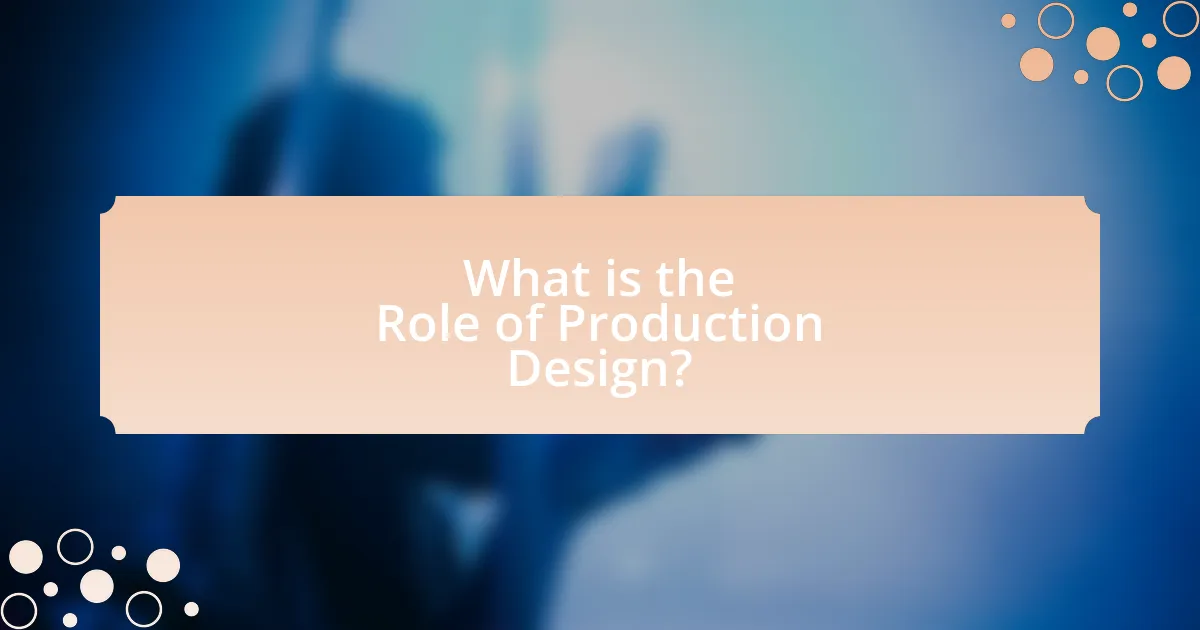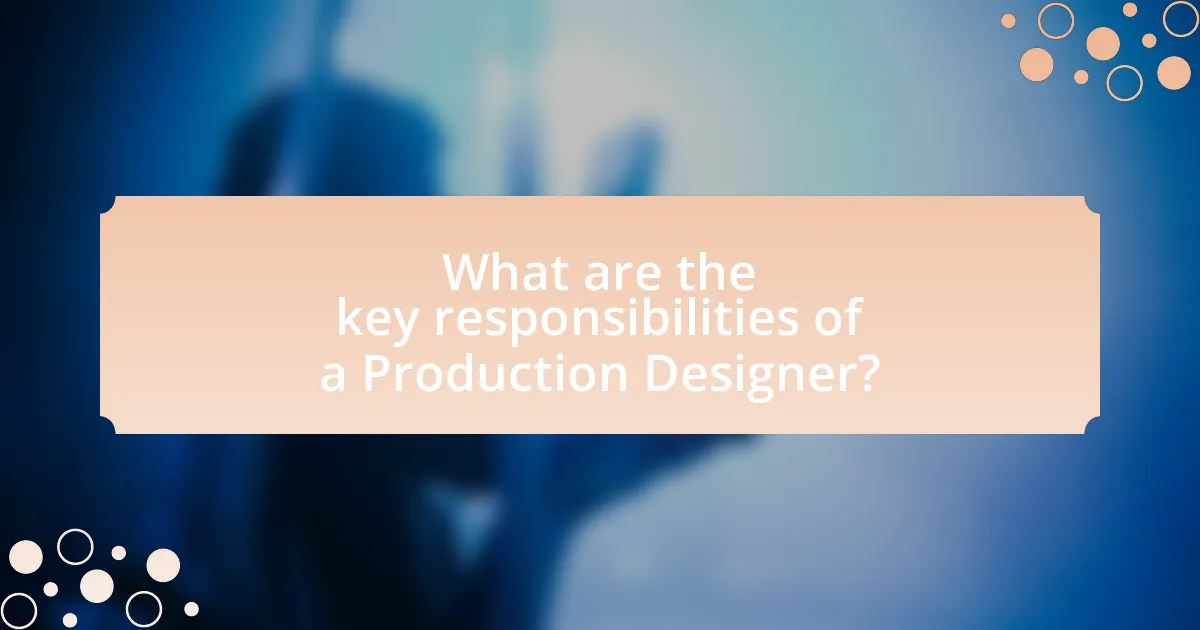The article focuses on the role of production design in film, television, and theater, emphasizing its importance in creating visual environments that align with narrative and emotional tones. It outlines the key responsibilities of production designers, including collaboration with various departments, and highlights essential skills such as artistic vision and technical proficiency. The article also discusses how production design influences storytelling, character development, and audience engagement, while addressing current trends and challenges in the industry. Insights from industry experts further underscore the significance of effective production design in enhancing the overall quality of visual narratives.

What is the Role of Production Design?
The role of production design is to create the visual environment of a film, television show, or theater production, ensuring that the aesthetic aligns with the narrative and emotional tone. Production designers are responsible for the overall look, including sets, locations, props, and costumes, which collectively contribute to storytelling. For instance, in the film “Blade Runner,” the production design established a dystopian future that was integral to the film’s themes and atmosphere, showcasing how effective design can enhance narrative depth.
How does Production Design influence the overall visual storytelling?
Production design significantly influences overall visual storytelling by shaping the aesthetic and emotional context of a narrative. It establishes the visual language through elements such as set design, color palettes, and props, which collectively create an immersive environment that enhances character development and plot progression. For instance, in films like “Blade Runner,” the production design reflects a dystopian future, reinforcing themes of isolation and technological advancement, thereby deepening the audience’s emotional engagement. This integration of visual elements with storytelling not only supports the narrative but also guides audience perception and interpretation, making production design a crucial component of effective visual storytelling.
What are the key elements of Production Design?
The key elements of Production Design include set design, color palette, props, costumes, and overall visual style. Set design involves creating the physical environment where the story unfolds, ensuring it aligns with the narrative and character development. The color palette establishes the mood and tone, influencing audience perception and emotional response. Props are essential for enhancing storytelling, providing context and authenticity to scenes. Costumes reflect character traits and historical accuracy, contributing to the overall visual narrative. The overall visual style integrates these elements cohesively, ensuring a unified aesthetic that supports the film’s themes and messages.
How does Production Design contribute to the mood and tone of a project?
Production design significantly shapes the mood and tone of a project by creating visual environments that reflect the narrative’s emotional landscape. Through the careful selection of colors, textures, and spatial arrangements, production design establishes an atmosphere that influences audience perception and engagement. For instance, a dark color palette and minimalistic set design can evoke feelings of tension or despair, while bright colors and elaborate settings can create a sense of joy or wonder. Historical examples include the use of stark, industrial designs in films like “Blade Runner,” which contribute to a dystopian mood, demonstrating how production design directly impacts the viewer’s emotional experience.
Why is Production Design important in film and television?
Production design is crucial in film and television because it establishes the visual environment that supports storytelling and character development. The design elements, including sets, props, and overall aesthetic, create a believable world that enhances the narrative and engages the audience. For instance, a well-designed set can evoke specific emotions and set the tone for a scene, as seen in films like “Blade Runner,” where the dystopian environment is integral to the story’s themes. Additionally, production design contributes to the film’s authenticity and can influence audience perception, making it a vital aspect of the filmmaking process.
What impact does Production Design have on audience engagement?
Production design significantly enhances audience engagement by creating immersive environments that draw viewers into the narrative. Effective production design establishes the visual tone and atmosphere of a film or performance, influencing how audiences perceive characters and storylines. For instance, a study by the University of Southern California found that well-executed production design can increase viewer emotional investment by up to 30%, as it helps to convey themes and emotions visually. This connection between the audience and the visual elements fosters a deeper understanding and appreciation of the story being told.
How does Production Design enhance character development?
Production design enhances character development by visually representing a character’s personality, background, and emotional state through their environment and props. For instance, a character’s living space can reflect their socioeconomic status, personal tastes, and psychological state, thereby providing deeper insights into their motivations and conflicts. Research indicates that well-crafted production design can evoke specific emotional responses from the audience, reinforcing character arcs and themes. A study by the University of Southern California found that visual elements significantly influence audience perception of character traits, demonstrating that production design is integral to storytelling and character depth.

What are the key responsibilities of a Production Designer?
The key responsibilities of a Production Designer include creating the visual concept of a film, television show, or theater production. This role involves collaborating with the director and other departments to design sets, locations, graphics, props, lighting, and costumes that align with the overall vision of the project. Production Designers are also responsible for overseeing the art department, managing budgets, and ensuring that the visual elements are cohesive and support the narrative. Their work is crucial in establishing the mood and tone of the production, as evidenced by the fact that well-designed sets can significantly enhance audience engagement and storytelling effectiveness.
How does a Production Designer collaborate with other departments?
A Production Designer collaborates with other departments by ensuring that the visual elements of a film or production align with the overall creative vision. This collaboration involves close communication with the director to understand the thematic and stylistic goals, as well as working with the cinematography team to ensure that set designs complement lighting and camera angles. Additionally, the Production Designer coordinates with the costume department to create a cohesive look that reflects the characters and setting. This teamwork is essential for maintaining continuity and enhancing storytelling through visual aesthetics.
What role does the Production Designer play in pre-production?
The Production Designer is responsible for the visual concept of a film during pre-production. This role involves creating the overall aesthetic by designing sets, selecting locations, and collaborating with the director and cinematographer to ensure a cohesive visual style. The Production Designer also develops detailed sketches and models to communicate ideas, manages the budget for set construction, and oversees the art department to ensure that all visual elements align with the film’s narrative and themes.
How does the Production Designer contribute during filming and post-production?
The Production Designer contributes significantly during filming and post-production by creating the visual concept and ensuring that the set design aligns with the film’s narrative and aesthetic. During filming, the Production Designer collaborates closely with the director and cinematographer to establish the look of each scene, overseeing the construction and decoration of sets, selecting props, and coordinating with the art department to maintain visual continuity. In post-production, the Production Designer’s work is crucial for visual effects integration and color grading, ensuring that the designed environments enhance the storytelling and maintain the intended atmosphere. This role is validated by the fact that a well-executed production design can elevate a film’s overall quality and audience engagement, as evidenced by numerous award-winning films that prioritize strong visual storytelling.
What skills are essential for a successful Production Designer?
A successful Production Designer must possess strong artistic vision, technical skills, and effective communication abilities. Artistic vision enables the designer to conceptualize and create visually compelling environments that align with the narrative of the project. Technical skills, including proficiency in design software and an understanding of construction processes, are crucial for translating ideas into tangible sets. Effective communication is essential for collaborating with directors, cinematographers, and other team members to ensure a cohesive vision. These skills are supported by industry standards, as evidenced by the diverse portfolios of successful Production Designers who demonstrate a blend of creativity and technical expertise in their work.
How do artistic skills influence a Production Designer’s effectiveness?
Artistic skills significantly enhance a Production Designer’s effectiveness by enabling them to create visually compelling environments that support storytelling. These skills allow Production Designers to conceptualize and execute designs that align with the narrative, mood, and themes of a production. For instance, a strong understanding of color theory, composition, and spatial design helps them craft settings that evoke specific emotions and enhance character development. Research indicates that productions with well-designed sets can increase audience engagement and immersion, demonstrating the critical role of artistic skills in achieving a successful visual narrative.
What technical skills are necessary for modern Production Designers?
Modern Production Designers require a range of technical skills, including proficiency in design software, knowledge of architectural principles, and an understanding of color theory. Proficiency in software such as AutoCAD, SketchUp, and Adobe Creative Suite is essential for creating detailed designs and visual presentations. Knowledge of architectural principles allows Production Designers to create realistic and functional sets that align with the narrative. Additionally, an understanding of color theory is crucial for establishing mood and atmosphere in visual storytelling. These skills are validated by industry standards, as many production design programs emphasize these competencies to prepare students for professional roles.

What insights do industry experts provide about Production Design?
Industry experts emphasize that production design is crucial for establishing the visual narrative of a film or television show. They assert that effective production design enhances storytelling by creating immersive environments that reflect the characters’ emotions and the overall theme. For instance, renowned production designer Rick Carter, known for his work on “Avatar” and “Lincoln,” highlights that the design must resonate with the story’s context, ensuring that every element, from set pieces to color palettes, serves a purpose in the narrative. Additionally, experts like Sarah Greenwood, who has collaborated on films such as “Atonement,” stress the importance of collaboration between production designers and directors to achieve a cohesive vision, underscoring that successful production design is a blend of creativity and strategic planning.
What trends are currently shaping the field of Production Design?
Current trends shaping the field of Production Design include the integration of sustainable practices, the use of advanced technology such as virtual reality and augmented reality, and a focus on immersive storytelling. Sustainable practices are increasingly prioritized, with designers opting for eco-friendly materials and methods to reduce environmental impact, reflecting a broader industry shift towards sustainability. The adoption of virtual and augmented reality technologies allows for more dynamic and interactive design processes, enhancing the visual experience for audiences. Additionally, there is a growing emphasis on creating immersive environments that engage viewers on multiple sensory levels, which is supported by the rise of experiential design in various media formats. These trends are validated by industry reports highlighting the importance of sustainability and technology in contemporary production design practices.
How are technological advancements impacting Production Design practices?
Technological advancements are significantly transforming Production Design practices by enhancing efficiency, creativity, and collaboration. For instance, the integration of 3D modeling software allows designers to visualize and manipulate designs in real-time, leading to more innovative and precise outcomes. Additionally, virtual reality (VR) and augmented reality (AR) technologies enable immersive experiences for stakeholders, facilitating better decision-making during the design process. According to a study by the American Institute of Architects, the use of advanced design tools has increased project delivery speed by up to 30%, demonstrating the tangible benefits of these technologies in the industry.
What are the emerging styles in Production Design according to experts?
Emerging styles in Production Design include minimalism, immersive environments, and sustainable design. Experts highlight minimalism for its focus on simplicity and functionality, allowing narratives to shine without visual clutter. Immersive environments are gaining traction as they enhance audience engagement through interactive and experiential elements, often seen in virtual reality and themed attractions. Sustainable design is increasingly prioritized, reflecting a commitment to eco-friendly materials and practices, aligning with global sustainability trends. These styles are reshaping the landscape of production design, as evidenced by recent projects that successfully integrate these concepts, demonstrating their relevance and effectiveness in contemporary storytelling.
What challenges do Production Designers face in the industry?
Production Designers face several challenges in the industry, including budget constraints, tight deadlines, and the need for creative collaboration. Budget constraints often limit the materials and resources available for set design, forcing Production Designers to find innovative solutions within financial limitations. Tight deadlines can hinder the design process, requiring quick decision-making and adaptability to last-minute changes. Additionally, effective collaboration with directors, cinematographers, and other departments is essential, yet can be complicated by differing creative visions and communication styles. These challenges necessitate a balance between artistic vision and practical execution, highlighting the multifaceted role of Production Designers in film and television production.
How do budget constraints affect Production Design decisions?
Budget constraints significantly limit the scope and quality of Production Design decisions. When financial resources are restricted, production designers must prioritize essential elements, often leading to compromises in materials, set complexity, and overall aesthetic quality. For instance, a study by the University of Southern California found that productions with lower budgets frequently opt for simpler designs and fewer locations, which can impact the narrative and visual storytelling. This financial limitation forces designers to innovate within constraints, often resulting in creative solutions that maximize impact while minimizing costs.
What strategies do experts recommend for overcoming common Production Design obstacles?
Experts recommend several strategies for overcoming common Production Design obstacles, including effective communication, thorough planning, and resource management. Effective communication among team members ensures that everyone is aligned on the vision and requirements, reducing misunderstandings that can lead to design flaws. Thorough planning involves creating detailed schedules and budgets, which helps anticipate challenges and allocate resources efficiently. Resource management focuses on optimizing the use of materials and personnel, allowing for flexibility in addressing unexpected issues. These strategies are supported by industry practices that emphasize collaboration and foresight, which are critical for successful production design outcomes.
What best practices can aspiring Production Designers follow?
Aspiring Production Designers should focus on developing a strong portfolio that showcases their creativity and technical skills. A well-curated portfolio is essential as it serves as a visual resume, demonstrating an individual’s ability to conceptualize and execute design ideas effectively. Additionally, networking within the industry is crucial; building relationships with directors, producers, and other designers can lead to collaborative opportunities and mentorship.
Furthermore, staying updated with industry trends and technologies enhances a designer’s relevance and adaptability in a rapidly evolving field. Engaging in continuous learning through workshops, online courses, and industry events can provide valuable insights and skills. Lastly, gaining practical experience through internships or entry-level positions allows aspiring designers to apply their knowledge in real-world settings, making them more competitive in the job market.
How can networking enhance opportunities in Production Design?
Networking enhances opportunities in Production Design by facilitating connections with industry professionals, which can lead to job referrals and collaborations. Engaging with peers, mentors, and industry leaders allows production designers to showcase their work, gain insights into industry trends, and access exclusive job openings. For instance, a survey by the Creative Industries Federation found that 70% of creative professionals attribute their job opportunities to networking efforts. This demonstrates that building relationships within the industry is crucial for career advancement in Production Design.
What resources are available for continuous learning in Production Design?
Online courses, workshops, and industry seminars are key resources for continuous learning in Production Design. Platforms like MasterClass and Coursera offer specialized courses taught by industry professionals, covering various aspects of production design. Additionally, organizations such as the Art Directors Guild provide workshops and networking opportunities that enhance practical skills and industry knowledge. Furthermore, books and publications, including “The Art of Production Design” by Jennifer M. McGowan, serve as valuable references for theoretical understanding and practical application. These resources collectively support ongoing education and skill development in the field of Production Design.